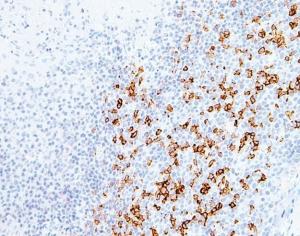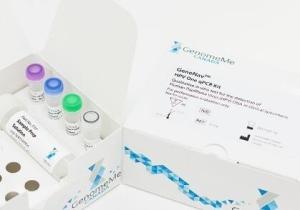
|



| 产地 | 中国 |
| 品牌 | GenomeMe |
| 货号 | IHC001 |
| 保存条件 | 2-8℃ |
| 保质期 | 2年个月 |
PD-1
背景描述Description:
ProgrammedDeath 1,PD-1)CD28/CTLA-4家族的一员,表达于活化的T细胞、B细胞和巨噬细胞表面。新的研究表明PD-1/PD-L1信号通路可能与免疫有关,因为PD-L1可诱导活化的T细胞凋亡或抑制细胞毒性T细胞的活性。与CD10和Bcl-6相比,PD-1由较少的B细胞表达,因此被认为是诊断免疫母细胞性T细胞的更特异、更有用的标记物。
Programmed Death 1 (PD-1) is a member of the CD28/CTLA-4 family of T-cell regulators, expressed as a co-receptor on the surface of activated T-cells, B-cells, and macrophages. New studies have suggested that the PD-1/PD-L1 signaling pathway may be linked to anti-tumor immunity, as PD-L1 has been shown to induce apoptosis of activated T cells or inhibit activity of cytotoxic T cells. In comparison to CD10 and Bcl-6, PD-1 is expressed by fewer B cells and has therefore been considered a more specific and useful diagnostic marker for angioimmunoblastic T-cell lymphoma. Therapies targeted toward the PD-1 receptor have shown remarkable clinical responses in patients with various types of cancer, including non–small-cell lung cancer, melanoma, and renal-cell cancer.
Specifications:
Clone IHC001
Source Mouse Monoclonal
Positive Control Tonsil, Lymph Node
Dilution Range 1:50-1:200
参考文献References:
Dorfman DM, et al. Am J Surg Pathol. 2006; 30:802-10.
Hamanishi J, et al. Proc Natl Acad Sci USA. 2007; 104:3360-5.
Kobayashi M, et al. J Rheumatol. 2005; 32:2156-63.
Konishi J, et al. Clin Cancer Res. 2004; 10:5094-100.
Mataki N, et al. Am J Gastroenterol. 2007; 102:302-12.
Kim JW, et al. Oncology (Williston Park). 2014; 28:15-28.
Tumeh PC, et al. Nature. 2014; 515:568-71.
D’Incecco A, et al. Br J Cancer. 2015; 112:95-102.
Tykodi SS. Onco Targets Ther. 2014; 7:1349-59.